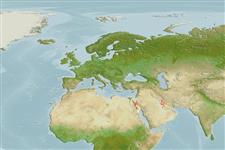Classification / Names
ຊື່ສາມັນ | ຄຳສັບຄ້າຍຄືກັນ | Catalog of Fishes(ຕະກຸນ, ຊະນິດ) | ITIS | CoL | WoRMS | Cloffa
>
Eupercaria/misc (Various families in series Eupercaria) >
Labridae (Wrasses) > Cheilininae
Etymology: Pteragogus: Greek, pteron = wing, fin + Greek, ago = to drive (Ref. 45335); trispilus: Named trispilus from the Latin for the three black spots anteriorly on the dorsal fin, one on each of the first three membranes (Ref. 93522).
Environment: milieu / climate zone / depth range / distribution range
ນິເວດວິທະຍາ
ສັດທະເລ ກ່ຽວກັນຫີນ; ລະດັບຄວາມເລິກ 9 - 35 m (Ref. 93522). Subtropical
Red Sea: Gulf of Aqaba and Gulf of Suez. Mediterranean Sea: Lessepsian migrant to the eastern Mediterranean Sea, primarily as Pteragogus pelycus.
ຂະໜາດ / ນ້ຳໜັກ / Age
Maturity: Lm ? range ? - ? cm
Max length : 7.9 cm SL ຕົວຜູ້/ບໍ່ມີເພດ; (Ref. 93522)
Short description
ສະລີລະວິທະຍາ | ການວັດແທກຮູບຮ່າງລັກສະນະພາຍນອກຂອງດິນ,ສັດ,ປາ…
ຄີ (ໜາມ)ແຂງຢູ່ຫຼັງປາ (ທັງໝົດ): 11; ຄີຫຼັງຂອງປາ (ຄີອ່ອນ) (ທັງໝົດ): 9; ຄີ(ໜາມ) ແຂງຢູ່ຄີກົ້ນປາ
ກຸ່ມປາກະດູກແຂງ
ຄວາມຖີ່ຂອງກຸ່ມຖ່າຍທອດພັນ
ປາທີ່ມີການເຄື່ອນຍ້າຍຈາກທະເລໄປຫານ້ຳຈືດ ແລະນ້ຳຈືດຫາທະເລ
ປາທີ່ມີການເຄື່ອນຍ້າຍຈາກທະເລແລະໄປໄຂ່ຢູ່ນ້ຳຈືດ
ຄີກົ້ນຂອງປາ
ສັດທີ່ມີກະດູກສັນຫັຼງ
ການຖ່າຍທອດທາງກຳມະພັນຈາກພໍ່ແມ່ຫາລູກ 3; ຄີກົ້ນຂອງປາ: 9; ສັດທີ່ມີກະດູກສັນຫຼັງ: 25. This species is distinguished by the following characters: D XI,9; A III,9; pectoral rays 13 (rarely 12); complete lateral line, angling sharply downward below soft part of anal fin to straight peduncular part; pored scales 24 (plus 2 on base of caudal fin, the last greatly enlarged); body moderately deep, depth 2.75-2.95 in SL; head length 2.7 in SL; dorsal profile of head straight in adult female, with adult male, a very a slight concavity above eye; interorbital convex; orbit diameter 4.15-5.4 in head length; straight part of posterior margin of preopercle serrate, the serrae varying from 14 on 27-mm paratype to 23 on 73-mm holotype; no long filaments extending from tips of dorsal spines; caudal fin rounded and moderately long, 2.7-3.1 in SL; very long first soft ray of pelvic fins, 2.0-3.3 in SL. Color when fresh olivaceous, scale edges dotted with white, an oblique elliptical black spot on opercle, broadly rimmed in yellow, a vertical white streak to each side of posterior edge of preopercle, scattered small black spots behind eye and on nape, pupil rimmed with orange, the rest of iris with 7 spoke-like dark lines, lateral line with black dots and dashes and white dots, median fins olivaceous with white dots on rays and oblique white lines on spinous portion ventral part of head and posterior opercle of male suffused with orange, females may have a whitish stripe from front of snout and broadening to pupil depth as it passes posteriorly on body below lateral line to upper base of caudal fin, longitudinal rows of white spots may be present on body ventral to pectoral-fin base, as well as faint orange spots; alcohol-preserved, yellowish brown with faint dark spots and dashes along anterior part of lateral line, fins translucent yellowish with a black spot on each of first three spinous membranes of dorsal fin of males (half size on third membrane), 2 spots on adult females (sometimes as faint small spot on third membrane) (Ref. 93522).
Collected with rotenone or spear in areas with sand bottom with detached brown algae or small coral patches and rocks. A very cryptic species, hence difficult to photograph underwater. The small sample of stomach contents from the holotype contained foraminiferans and from the 7.35 cm paratype consisted mainly of crushed remains of small gastropods, some foraminiferans, and unidentified crustacean fragments, including a small crab chela. Also from the very large stomach of the 4.4 cm paratype, it was found to contain the remains of a moderately large shrimp, so this fish does not feed exclusively on tiny prey (Ref. 93522). Maximum depth reported taken from Ref. 127989.
Life cycle and mating behavior
ການຈະເລີນເຕັມໄວ | ການສືບພັນ | ການວາງໄຂ່ | ໄຂ່ | ຄວາມດົກຂອງໄຂ່ປາ | ຕົວອ່ອນ
Oviparous, distinct pairing during breeding (Ref. 205).
Randall, J.E., 2013. Seven new species of labrid fishes (Coris, Iniistius, Macropharyngodon, Novaculops, and Pteragogus) from the Western Indian Ocean. J. Ocean Sci. Found. 7:1-43. (Ref. 93522)
IUCN Red List Status (Ref. 130435)
Threat to humans
Harmless
Human uses
ການປະມົງ:
ຂໍ້ມູນຕື່ມອີກ
ຊື່ສາມັນຄຳສັບຄ້າຍຄືກັນການເຜົາໃໝ້ພະລັງງານໂດຍປ່ຽນທາດອາຫານໃນຮ່າງກາຍໃຫ້ກາຍເປັນຊີ້ນແລະໜັງຜູ້ລ້າການສຶກສາຜົນກະທົບຂອງສານຜິດທີ່ມີຜົນກະທົບຕໍ່ລະບົບນິເວດການສືບພັນການຈະເລີນເຕັມໄວການວາງໄຂ່ການສັງລວມການວາງໄຂ່ຄວາມດົກຂອງໄຂ່ປາໄຂ່Egg development
Age/Sizeການເຕີບໃຫຍ່Length-weightLength-lengthLength-frequenciesການວັດແທກຮູບຮ່າງລັກສະນະພາຍນອກຂອງດິນ,ສັດ,ປາ…ສະລີລະວິທະຍາຕົວອ່ອນການປ່ຽນແປງຂອງຕົວອ່ອນການທົດແທນທີ່ຄວາມອຸດົມສົມບູນBRUVS
ເອກະສານອ້າງອີງການລ້ຽງສັດນ້ຳຂໍ້ມູນການລ້ຽງສັດນ້ຳສາຍພັນກຳມະພັນElectrophoresesການຖ່າຍທອດທາງກຳມະພັນຈາກພໍ່ແມ່ຫາລູກພະຍາດການປຸງແຕ່ງNutrientsMass conversion
ຜູ້ຮ່ວມມືຮູບStamps, Coins Misc.ສຽງຫອຍມີພິດຊະນິດນຶ່ງທີ່ອາໄສໃນທະເລຄວາມໄວປະເພດການລອຍເນື້ອທີ່ເຫືອກOtolithsສະໝອງວິໄສທັດ
ເຄື່ອງມື
Special reports
Download XML
ແຫຼ່ງອີນເຕີເນັດ
Estimates based on models
Preferred temperature (Ref.
123201): 22.2 - 27.2, mean 25.1 °C (based on 48 cells).
Phylogenetic diversity index (Ref.
82804): PD
50 = 0.5010 [Uniqueness, from 0.5 = low to 2.0 = high].
Bayesian length-weight: a=0.02188 (0.00887 - 0.05395), b=2.97 (2.76 - 3.18), in cm total length, based on LWR estimates for this (Sub)family-body shape (Ref.
93245).
ຊັ້ນເຂດຮ້ອນ (Ref.
69278): 3.4 ±0.4 se; based on size and trophs of closest relatives
ຄວາມຢືດຢຸ່ນ (Ref.
120179): ສູງ, ປະຊາກອນຕຳ່ສຸດທີ່ໃຊ້ເວລາສອງໜ້ອຍກວ່າ 15 ເດືອນ (Preliminary K or Fecundity.).
Fishing Vulnerability (Ref.
59153): Low vulnerability (10 of 100).
